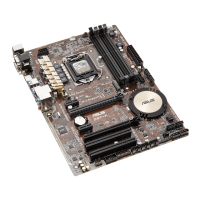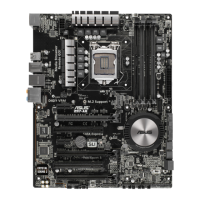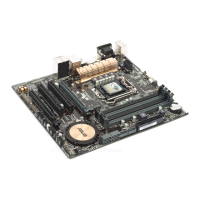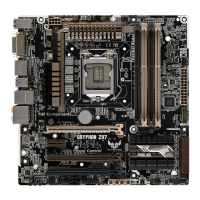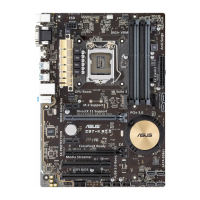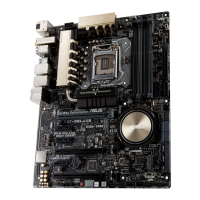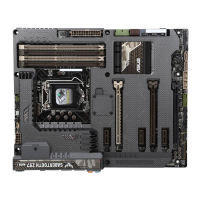Do you have a question about the Asus Z97I-PLUS and is the answer not in the manual?
Key hardware features of the motherboard.
ASUS protection features for reliability.
Diagram and identification of motherboard components.
Diagram and identification of motherboard components.
Details about the CPU socket and compatibility.
Information on RAM slots and memory installation.
Details on PCI Express and other expansion slots.
Detailed list and location of internal connectors.
Step-by-step guide to install the motherboard.
Step-by-step guide to install the motherboard.
Instructions for installing the CPU correctly.
Guide to install CPU cooler assembly.
Steps for installing RAM modules.
How to connect the ATX power supply.
Connecting SATA hard drives.
Connecting front panel connectors like USB and audio.
Instructions for installing expansion cards.
Simplified BIOS interface.
Comprehensive BIOS settings.
Utility for easy BIOS updates.
Power management features.
Explanation of RAID levels.
Creating driver disk offline.
Precautions related to electrical hazards.
Safety guidelines during product operation.
Details on CPU socket, generation, and processor support.
Chipset model and system memory specifications.
Information on expansion slots and integrated graphics.
Storage interfaces, LAN, Wi-Fi, and Bluetooth features.
Core protection features for reliability and durability.
High-speed M.2 slot for storage devices.
USB enhancements, thermal design, and overclocking utilities.
Key hardware features of the motherboard.
ASUS protection features for reliability.
Diagram and identification of motherboard components.
Diagram and identification of motherboard components.
Details about the CPU socket and compatibility.
Information on RAM slots and memory installation.
Details on PCI Express and other expansion slots.
Detailed list and location of internal connectors.
Step-by-step guide to install the motherboard.
Step-by-step guide to install the motherboard.
Instructions for installing the CPU correctly.
Guide to install CPU cooler assembly.
Steps for installing RAM modules.
How to connect the ATX power supply.
Connecting SATA hard drives.
Connecting front panel connectors like USB and audio.
Instructions for installing expansion cards.
Simplified BIOS interface.
Comprehensive BIOS settings.
Utility for easy BIOS updates.
Power management features.
Explanation of RAID levels.
Creating driver disk offline.
Precautions related to electrical hazards.
Safety guidelines during product operation.
Details on CPU socket, generation, and processor support.
Chipset model and system memory specifications.
Information on expansion slots and integrated graphics.
Storage interfaces, LAN, Wi-Fi, and Bluetooth features.
Core protection features for reliability and durability.
High-speed M.2 slot for storage devices.
USB enhancements, thermal design, and overclocking utilities.
| Non-ECC | Yes |
|---|---|
| Memory channels | Dual-channel |
| Memory slots type | DIMM |
| Number of memory slots | 2 |
| Supported memory types | DDR3-SDRAM |
| Maximum internal memory | 16 GB |
| Supported memory clock speeds | 1333, 1600, 1866, 2000, 2200, 2400, 2600, 2666, 2800, 2933, 3050, 3100, 3200 MHz |
| Processor socket | LGA 1150 (Socket H3) |
| Processor manufacturer | Intel |
| Compatible processor series | Intel® Celeron® |
| USB 2.0 connectors | 1 |
| Number of SATA III connectors | 4 |
| Number of Parallel ATA connectors | - |
| RAID levels | 0, 1, 5, 10 |
| Supported storage drive interfaces | SATA III |
| USB 2.0 ports quantity | USB 2.0 ports have a data transmission speed of 480 Mbps, and are backwards compatible with USB 1.1 ports. You can connect all kinds of peripheral devices to them. |
| LAN controller | Intel® I218-V |
| Bluetooth version | 4.0 |
| Ethernet interface type | Gigabit Ethernet |
| Component for | PC |
| Power source type | ATX |
| Motherboard chipset | Intel® Z97 |
| Audio output channels | 7.1 channels |
| Motherboard form factor | mini ITX |
| BIOS type | UEFI AMI |
| ACPI version | 5.0 |
| BIOS memory size | 64 Mbit |
| Width | 170 mm |
|---|
